Taxation Law Assignment: Deductions, Balancing Adjustments, Income
VerifiedAdded on 2020/04/01
|8
|1613
|476
Homework Assignment
AI Summary
This Taxation Law assignment solution covers key aspects of Australian taxation law, addressing various scenarios related to allowable deductions under ITAA 1997, balancing adjustments as per section 40-295, and the taxability of different types of income. The assignment provides detailed answers to questions concerning accrued wages, advertising expenses, depreciation, interest, insurance, lease payments, long service leave, repairs, staff training, and taxation expenses, determining their eligibility as deductions. It analyzes situations that trigger balancing adjustments due to changes in asset usage. Furthermore, it examines the tax treatment of compensation for personal injury, fringe benefits, and social security disability support payments under relevant sections of the ITAA 1936. The solution is supported by references to relevant legislation and tax rulings.
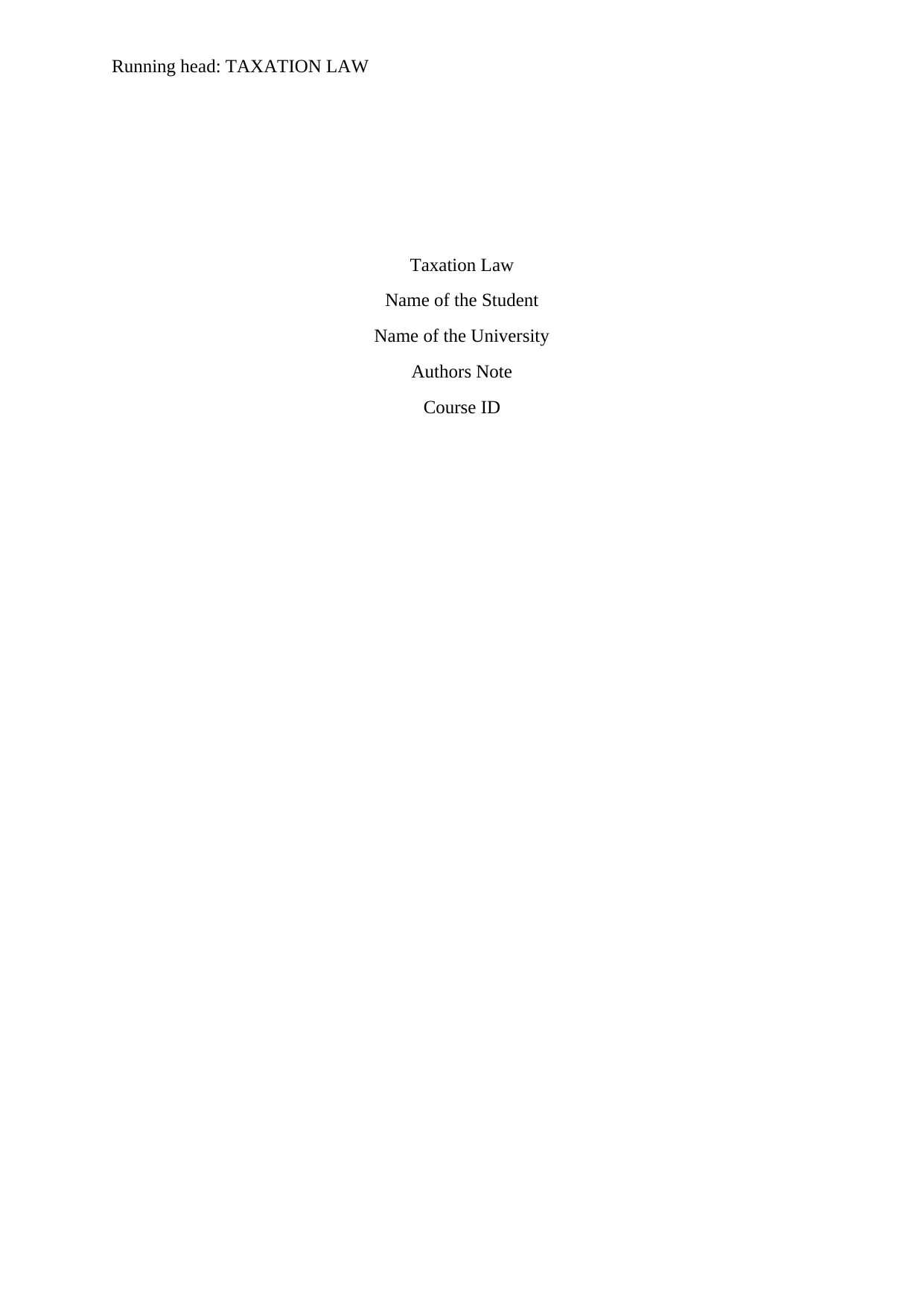
Running head: TAXATION LAW
Taxation Law
Name of the Student
Name of the University
Authors Note
Course ID
Taxation Law
Name of the Student
Name of the University
Authors Note
Course ID
Paraphrase This Document
Need a fresh take? Get an instant paraphrase of this document with our AI Paraphraser
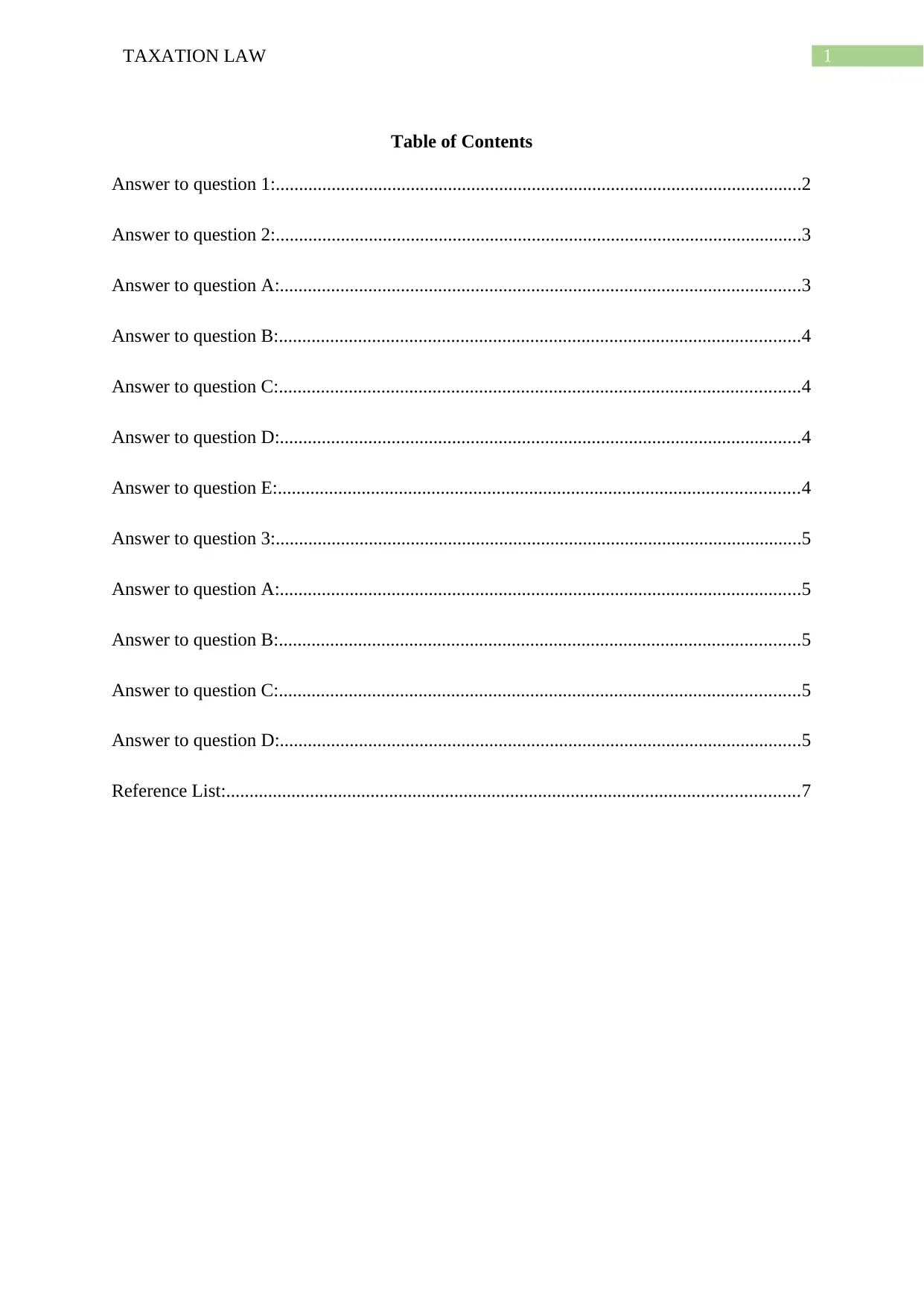
1TAXATION LAW
Table of Contents
Answer to question 1:.................................................................................................................2
Answer to question 2:.................................................................................................................3
Answer to question A:................................................................................................................3
Answer to question B:................................................................................................................4
Answer to question C:................................................................................................................4
Answer to question D:................................................................................................................4
Answer to question E:................................................................................................................4
Answer to question 3:.................................................................................................................5
Answer to question A:................................................................................................................5
Answer to question B:................................................................................................................5
Answer to question C:................................................................................................................5
Answer to question D:................................................................................................................5
Reference List:...........................................................................................................................7
Table of Contents
Answer to question 1:.................................................................................................................2
Answer to question 2:.................................................................................................................3
Answer to question A:................................................................................................................3
Answer to question B:................................................................................................................4
Answer to question C:................................................................................................................4
Answer to question D:................................................................................................................4
Answer to question E:................................................................................................................4
Answer to question 3:.................................................................................................................5
Answer to question A:................................................................................................................5
Answer to question B:................................................................................................................5
Answer to question C:................................................................................................................5
Answer to question D:................................................................................................................5
Reference List:...........................................................................................................................7
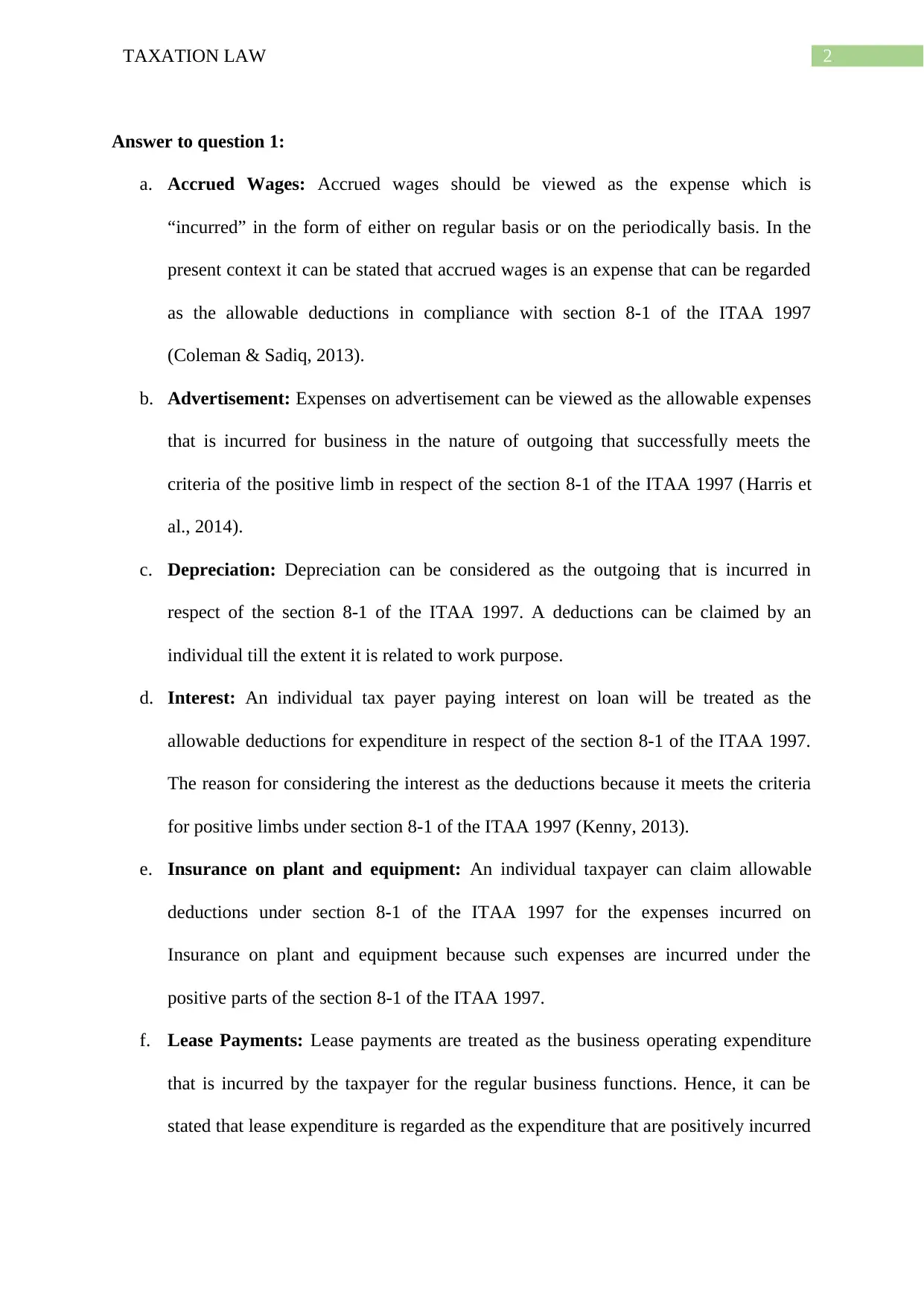
2TAXATION LAW
Answer to question 1:
a. Accrued Wages: Accrued wages should be viewed as the expense which is
“incurred” in the form of either on regular basis or on the periodically basis. In the
present context it can be stated that accrued wages is an expense that can be regarded
as the allowable deductions in compliance with section 8-1 of the ITAA 1997
(Coleman & Sadiq, 2013).
b. Advertisement: Expenses on advertisement can be viewed as the allowable expenses
that is incurred for business in the nature of outgoing that successfully meets the
criteria of the positive limb in respect of the section 8-1 of the ITAA 1997 (Harris et
al., 2014).
c. Depreciation: Depreciation can be considered as the outgoing that is incurred in
respect of the section 8-1 of the ITAA 1997. A deductions can be claimed by an
individual till the extent it is related to work purpose.
d. Interest: An individual tax payer paying interest on loan will be treated as the
allowable deductions for expenditure in respect of the section 8-1 of the ITAA 1997.
The reason for considering the interest as the deductions because it meets the criteria
for positive limbs under section 8-1 of the ITAA 1997 (Kenny, 2013).
e. Insurance on plant and equipment: An individual taxpayer can claim allowable
deductions under section 8-1 of the ITAA 1997 for the expenses incurred on
Insurance on plant and equipment because such expenses are incurred under the
positive parts of the section 8-1 of the ITAA 1997.
f. Lease Payments: Lease payments are treated as the business operating expenditure
that is incurred by the taxpayer for the regular business functions. Hence, it can be
stated that lease expenditure is regarded as the expenditure that are positively incurred
Answer to question 1:
a. Accrued Wages: Accrued wages should be viewed as the expense which is
“incurred” in the form of either on regular basis or on the periodically basis. In the
present context it can be stated that accrued wages is an expense that can be regarded
as the allowable deductions in compliance with section 8-1 of the ITAA 1997
(Coleman & Sadiq, 2013).
b. Advertisement: Expenses on advertisement can be viewed as the allowable expenses
that is incurred for business in the nature of outgoing that successfully meets the
criteria of the positive limb in respect of the section 8-1 of the ITAA 1997 (Harris et
al., 2014).
c. Depreciation: Depreciation can be considered as the outgoing that is incurred in
respect of the section 8-1 of the ITAA 1997. A deductions can be claimed by an
individual till the extent it is related to work purpose.
d. Interest: An individual tax payer paying interest on loan will be treated as the
allowable deductions for expenditure in respect of the section 8-1 of the ITAA 1997.
The reason for considering the interest as the deductions because it meets the criteria
for positive limbs under section 8-1 of the ITAA 1997 (Kenny, 2013).
e. Insurance on plant and equipment: An individual taxpayer can claim allowable
deductions under section 8-1 of the ITAA 1997 for the expenses incurred on
Insurance on plant and equipment because such expenses are incurred under the
positive parts of the section 8-1 of the ITAA 1997.
f. Lease Payments: Lease payments are treated as the business operating expenditure
that is incurred by the taxpayer for the regular business functions. Hence, it can be
stated that lease expenditure is regarded as the expenditure that are positively incurred
⊘ This is a preview!⊘
Do you want full access?
Subscribe today to unlock all pages.

Trusted by 1+ million students worldwide
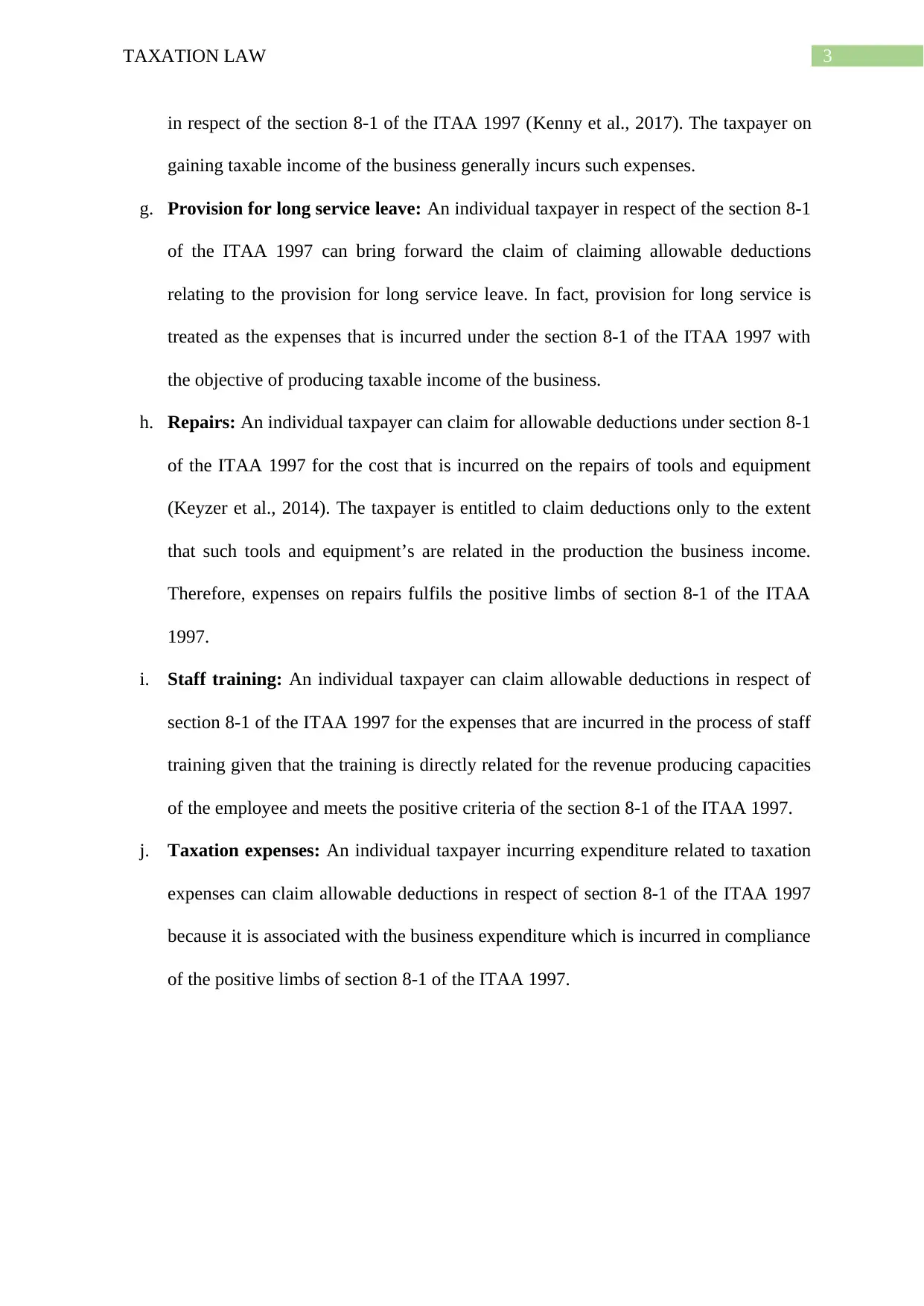
3TAXATION LAW
in respect of the section 8-1 of the ITAA 1997 (Kenny et al., 2017). The taxpayer on
gaining taxable income of the business generally incurs such expenses.
g. Provision for long service leave: An individual taxpayer in respect of the section 8-1
of the ITAA 1997 can bring forward the claim of claiming allowable deductions
relating to the provision for long service leave. In fact, provision for long service is
treated as the expenses that is incurred under the section 8-1 of the ITAA 1997 with
the objective of producing taxable income of the business.
h. Repairs: An individual taxpayer can claim for allowable deductions under section 8-1
of the ITAA 1997 for the cost that is incurred on the repairs of tools and equipment
(Keyzer et al., 2014). The taxpayer is entitled to claim deductions only to the extent
that such tools and equipment’s are related in the production the business income.
Therefore, expenses on repairs fulfils the positive limbs of section 8-1 of the ITAA
1997.
i. Staff training: An individual taxpayer can claim allowable deductions in respect of
section 8-1 of the ITAA 1997 for the expenses that are incurred in the process of staff
training given that the training is directly related for the revenue producing capacities
of the employee and meets the positive criteria of the section 8-1 of the ITAA 1997.
j. Taxation expenses: An individual taxpayer incurring expenditure related to taxation
expenses can claim allowable deductions in respect of section 8-1 of the ITAA 1997
because it is associated with the business expenditure which is incurred in compliance
of the positive limbs of section 8-1 of the ITAA 1997.
in respect of the section 8-1 of the ITAA 1997 (Kenny et al., 2017). The taxpayer on
gaining taxable income of the business generally incurs such expenses.
g. Provision for long service leave: An individual taxpayer in respect of the section 8-1
of the ITAA 1997 can bring forward the claim of claiming allowable deductions
relating to the provision for long service leave. In fact, provision for long service is
treated as the expenses that is incurred under the section 8-1 of the ITAA 1997 with
the objective of producing taxable income of the business.
h. Repairs: An individual taxpayer can claim for allowable deductions under section 8-1
of the ITAA 1997 for the cost that is incurred on the repairs of tools and equipment
(Keyzer et al., 2014). The taxpayer is entitled to claim deductions only to the extent
that such tools and equipment’s are related in the production the business income.
Therefore, expenses on repairs fulfils the positive limbs of section 8-1 of the ITAA
1997.
i. Staff training: An individual taxpayer can claim allowable deductions in respect of
section 8-1 of the ITAA 1997 for the expenses that are incurred in the process of staff
training given that the training is directly related for the revenue producing capacities
of the employee and meets the positive criteria of the section 8-1 of the ITAA 1997.
j. Taxation expenses: An individual taxpayer incurring expenditure related to taxation
expenses can claim allowable deductions in respect of section 8-1 of the ITAA 1997
because it is associated with the business expenditure which is incurred in compliance
of the positive limbs of section 8-1 of the ITAA 1997.
Paraphrase This Document
Need a fresh take? Get an instant paraphrase of this document with our AI Paraphraser
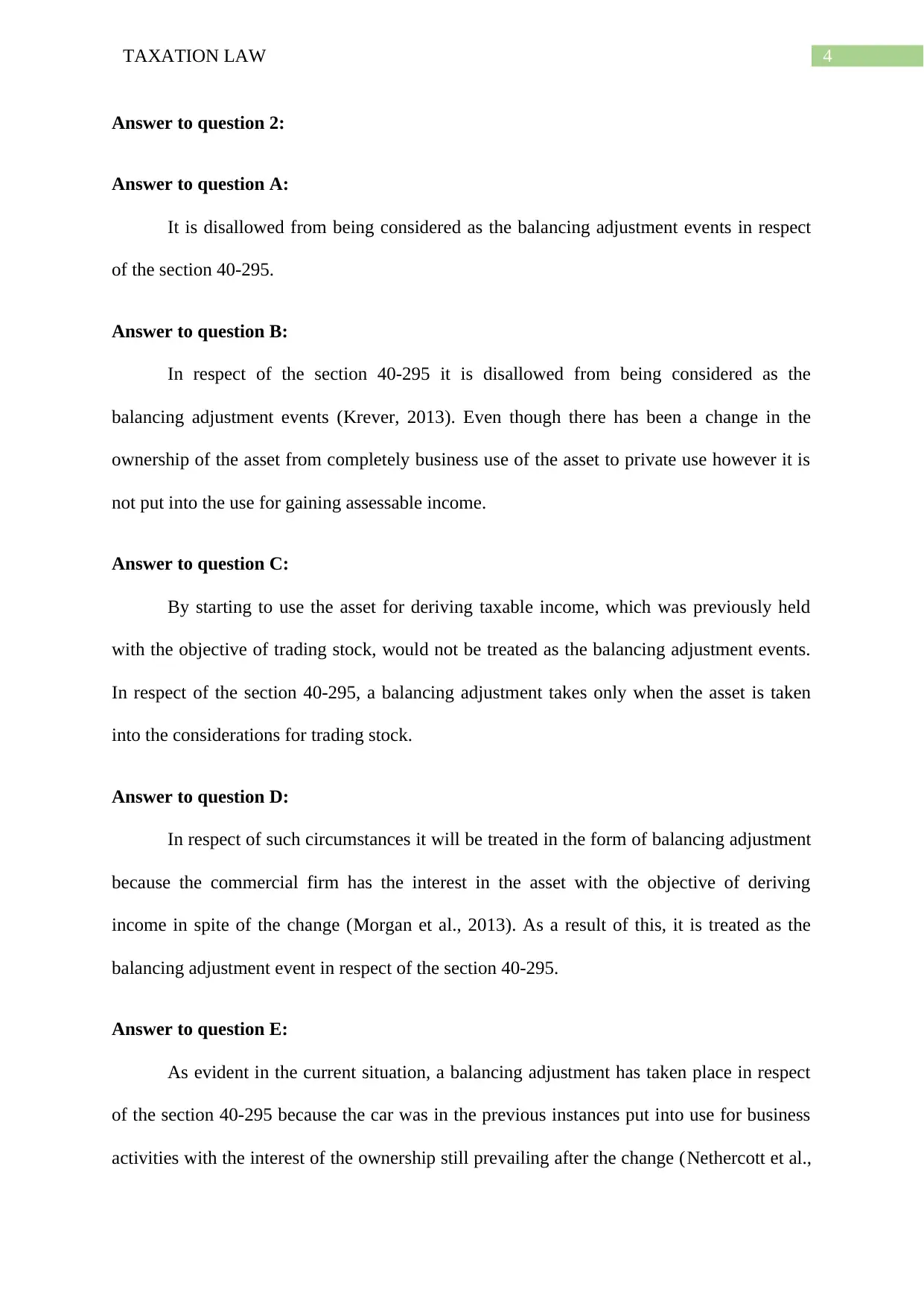
4TAXATION LAW
Answer to question 2:
Answer to question A:
It is disallowed from being considered as the balancing adjustment events in respect
of the section 40-295.
Answer to question B:
In respect of the section 40-295 it is disallowed from being considered as the
balancing adjustment events (Krever, 2013). Even though there has been a change in the
ownership of the asset from completely business use of the asset to private use however it is
not put into the use for gaining assessable income.
Answer to question C:
By starting to use the asset for deriving taxable income, which was previously held
with the objective of trading stock, would not be treated as the balancing adjustment events.
In respect of the section 40-295, a balancing adjustment takes only when the asset is taken
into the considerations for trading stock.
Answer to question D:
In respect of such circumstances it will be treated in the form of balancing adjustment
because the commercial firm has the interest in the asset with the objective of deriving
income in spite of the change (Morgan et al., 2013). As a result of this, it is treated as the
balancing adjustment event in respect of the section 40-295.
Answer to question E:
As evident in the current situation, a balancing adjustment has taken place in respect
of the section 40-295 because the car was in the previous instances put into use for business
activities with the interest of the ownership still prevailing after the change (Nethercott et al.,
Answer to question 2:
Answer to question A:
It is disallowed from being considered as the balancing adjustment events in respect
of the section 40-295.
Answer to question B:
In respect of the section 40-295 it is disallowed from being considered as the
balancing adjustment events (Krever, 2013). Even though there has been a change in the
ownership of the asset from completely business use of the asset to private use however it is
not put into the use for gaining assessable income.
Answer to question C:
By starting to use the asset for deriving taxable income, which was previously held
with the objective of trading stock, would not be treated as the balancing adjustment events.
In respect of the section 40-295, a balancing adjustment takes only when the asset is taken
into the considerations for trading stock.
Answer to question D:
In respect of such circumstances it will be treated in the form of balancing adjustment
because the commercial firm has the interest in the asset with the objective of deriving
income in spite of the change (Morgan et al., 2013). As a result of this, it is treated as the
balancing adjustment event in respect of the section 40-295.
Answer to question E:
As evident in the current situation, a balancing adjustment has taken place in respect
of the section 40-295 because the car was in the previous instances put into use for business
activities with the interest of the ownership still prevailing after the change (Nethercott et al.,
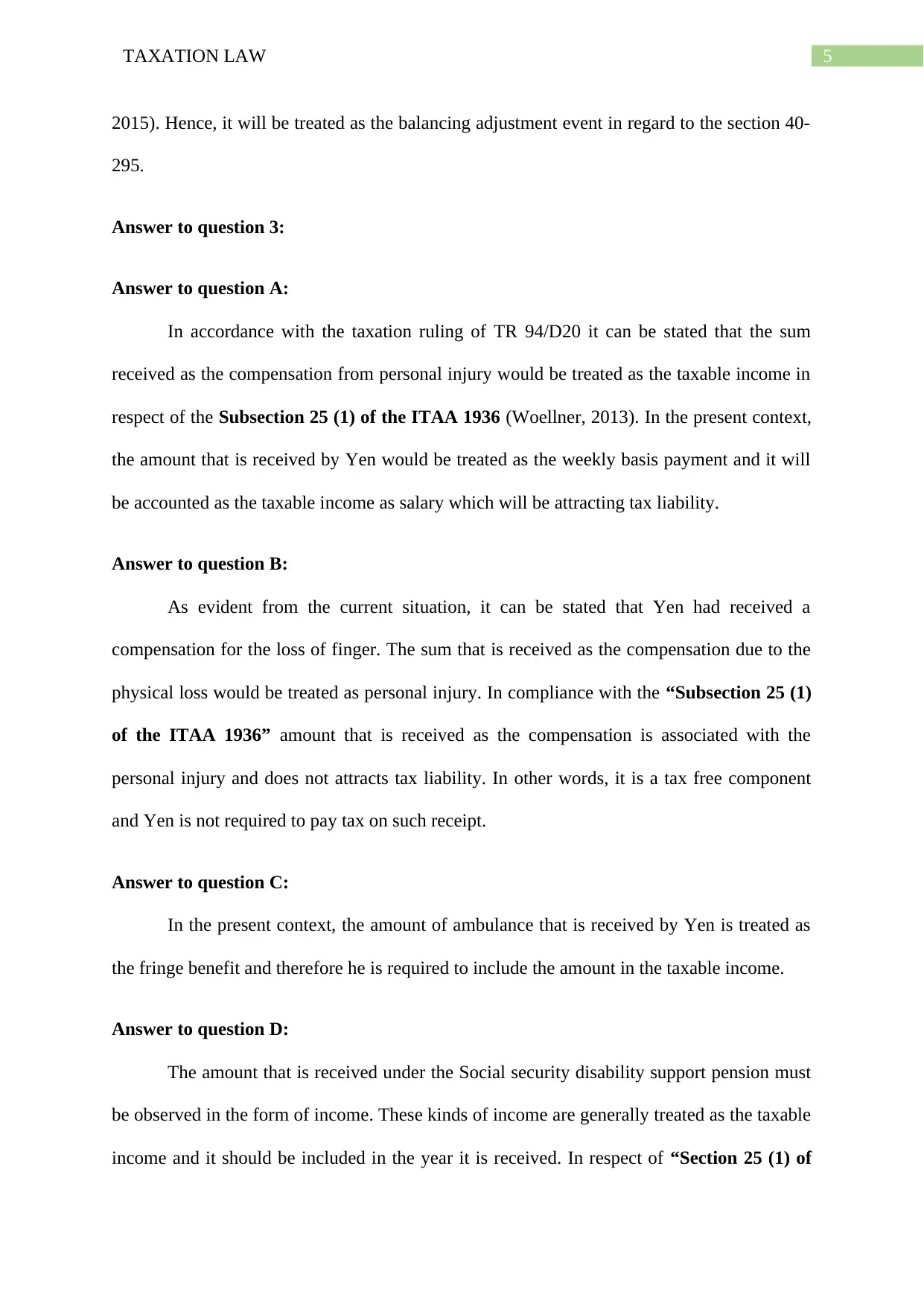
5TAXATION LAW
2015). Hence, it will be treated as the balancing adjustment event in regard to the section 40-
295.
Answer to question 3:
Answer to question A:
In accordance with the taxation ruling of TR 94/D20 it can be stated that the sum
received as the compensation from personal injury would be treated as the taxable income in
respect of the Subsection 25 (1) of the ITAA 1936 (Woellner, 2013). In the present context,
the amount that is received by Yen would be treated as the weekly basis payment and it will
be accounted as the taxable income as salary which will be attracting tax liability.
Answer to question B:
As evident from the current situation, it can be stated that Yen had received a
compensation for the loss of finger. The sum that is received as the compensation due to the
physical loss would be treated as personal injury. In compliance with the “Subsection 25 (1)
of the ITAA 1936” amount that is received as the compensation is associated with the
personal injury and does not attracts tax liability. In other words, it is a tax free component
and Yen is not required to pay tax on such receipt.
Answer to question C:
In the present context, the amount of ambulance that is received by Yen is treated as
the fringe benefit and therefore he is required to include the amount in the taxable income.
Answer to question D:
The amount that is received under the Social security disability support pension must
be observed in the form of income. These kinds of income are generally treated as the taxable
income and it should be included in the year it is received. In respect of “Section 25 (1) of
2015). Hence, it will be treated as the balancing adjustment event in regard to the section 40-
295.
Answer to question 3:
Answer to question A:
In accordance with the taxation ruling of TR 94/D20 it can be stated that the sum
received as the compensation from personal injury would be treated as the taxable income in
respect of the Subsection 25 (1) of the ITAA 1936 (Woellner, 2013). In the present context,
the amount that is received by Yen would be treated as the weekly basis payment and it will
be accounted as the taxable income as salary which will be attracting tax liability.
Answer to question B:
As evident from the current situation, it can be stated that Yen had received a
compensation for the loss of finger. The sum that is received as the compensation due to the
physical loss would be treated as personal injury. In compliance with the “Subsection 25 (1)
of the ITAA 1936” amount that is received as the compensation is associated with the
personal injury and does not attracts tax liability. In other words, it is a tax free component
and Yen is not required to pay tax on such receipt.
Answer to question C:
In the present context, the amount of ambulance that is received by Yen is treated as
the fringe benefit and therefore he is required to include the amount in the taxable income.
Answer to question D:
The amount that is received under the Social security disability support pension must
be observed in the form of income. These kinds of income are generally treated as the taxable
income and it should be included in the year it is received. In respect of “Section 25 (1) of
⊘ This is a preview!⊘
Do you want full access?
Subscribe today to unlock all pages.

Trusted by 1+ million students worldwide
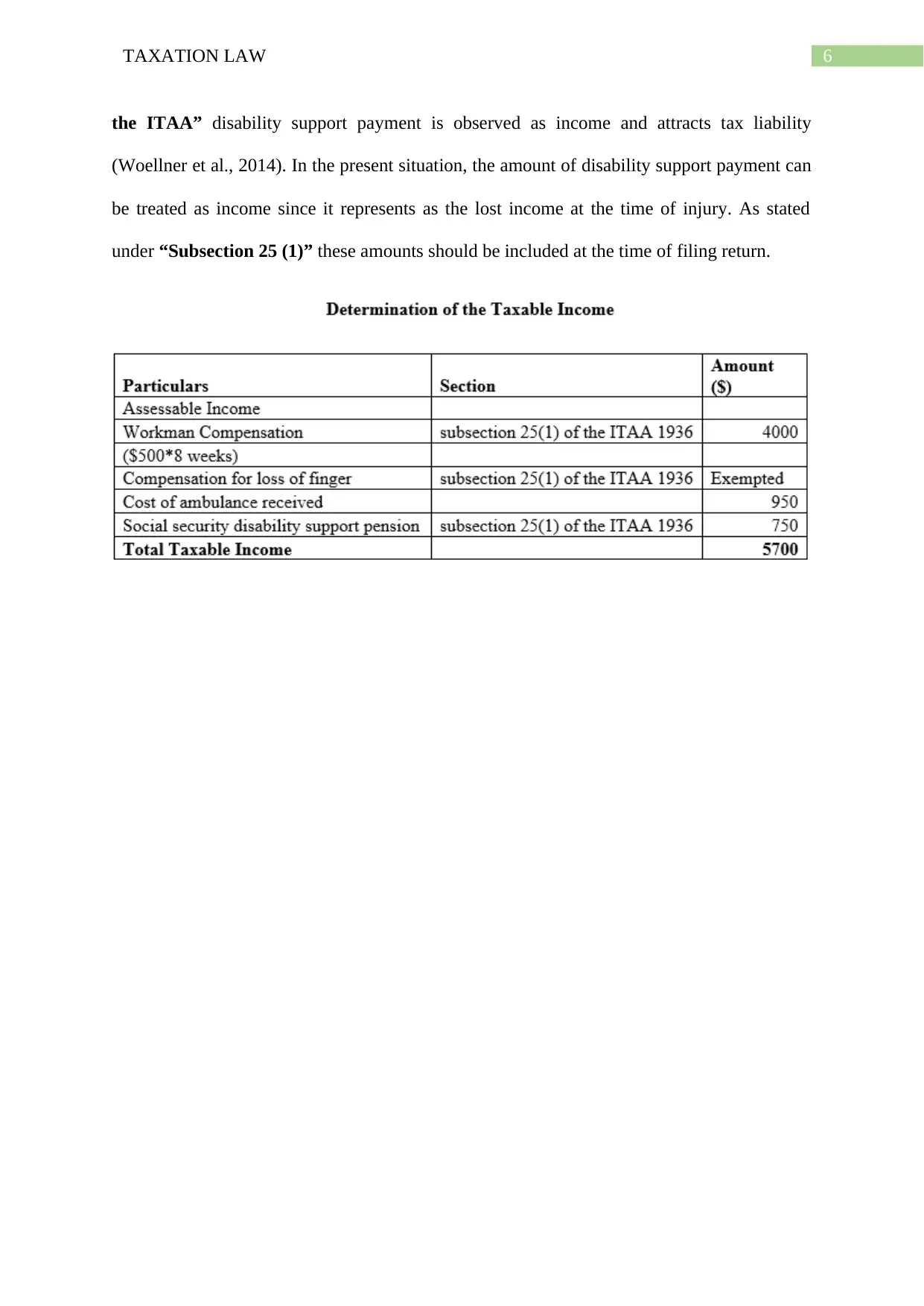
6TAXATION LAW
the ITAA” disability support payment is observed as income and attracts tax liability
(Woellner et al., 2014). In the present situation, the amount of disability support payment can
be treated as income since it represents as the lost income at the time of injury. As stated
under “Subsection 25 (1)” these amounts should be included at the time of filing return.
the ITAA” disability support payment is observed as income and attracts tax liability
(Woellner et al., 2014). In the present situation, the amount of disability support payment can
be treated as income since it represents as the lost income at the time of injury. As stated
under “Subsection 25 (1)” these amounts should be included at the time of filing return.
Paraphrase This Document
Need a fresh take? Get an instant paraphrase of this document with our AI Paraphraser
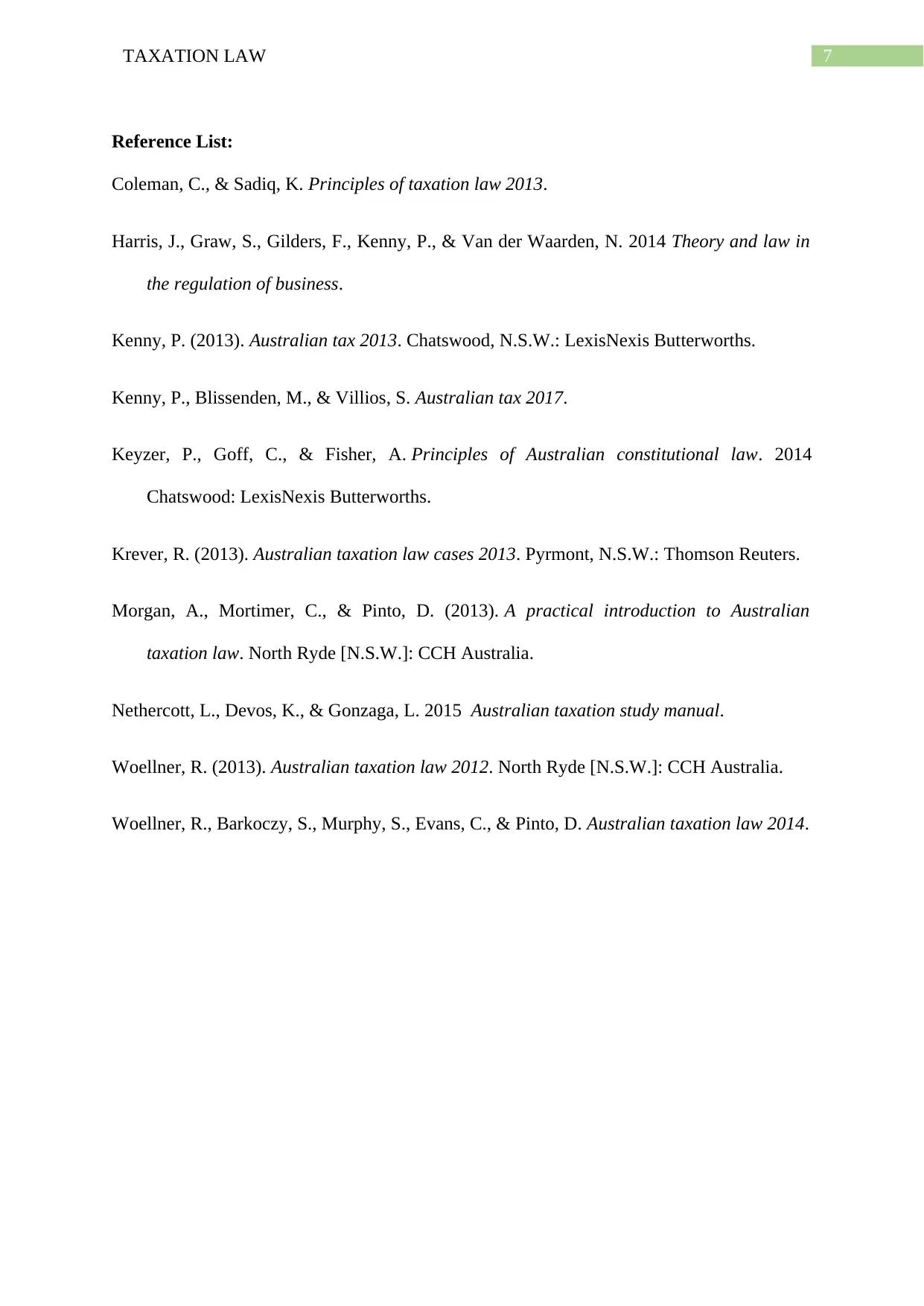
7TAXATION LAW
Reference List:
Coleman, C., & Sadiq, K. Principles of taxation law 2013.
Harris, J., Graw, S., Gilders, F., Kenny, P., & Van der Waarden, N. 2014 Theory and law in
the regulation of business.
Kenny, P. (2013). Australian tax 2013. Chatswood, N.S.W.: LexisNexis Butterworths.
Kenny, P., Blissenden, M., & Villios, S. Australian tax 2017.
Keyzer, P., Goff, C., & Fisher, A. Principles of Australian constitutional law. 2014
Chatswood: LexisNexis Butterworths.
Krever, R. (2013). Australian taxation law cases 2013. Pyrmont, N.S.W.: Thomson Reuters.
Morgan, A., Mortimer, C., & Pinto, D. (2013). A practical introduction to Australian
taxation law. North Ryde [N.S.W.]: CCH Australia.
Nethercott, L., Devos, K., & Gonzaga, L. 2015 Australian taxation study manual.
Woellner, R. (2013). Australian taxation law 2012. North Ryde [N.S.W.]: CCH Australia.
Woellner, R., Barkoczy, S., Murphy, S., Evans, C., & Pinto, D. Australian taxation law 2014.
Reference List:
Coleman, C., & Sadiq, K. Principles of taxation law 2013.
Harris, J., Graw, S., Gilders, F., Kenny, P., & Van der Waarden, N. 2014 Theory and law in
the regulation of business.
Kenny, P. (2013). Australian tax 2013. Chatswood, N.S.W.: LexisNexis Butterworths.
Kenny, P., Blissenden, M., & Villios, S. Australian tax 2017.
Keyzer, P., Goff, C., & Fisher, A. Principles of Australian constitutional law. 2014
Chatswood: LexisNexis Butterworths.
Krever, R. (2013). Australian taxation law cases 2013. Pyrmont, N.S.W.: Thomson Reuters.
Morgan, A., Mortimer, C., & Pinto, D. (2013). A practical introduction to Australian
taxation law. North Ryde [N.S.W.]: CCH Australia.
Nethercott, L., Devos, K., & Gonzaga, L. 2015 Australian taxation study manual.
Woellner, R. (2013). Australian taxation law 2012. North Ryde [N.S.W.]: CCH Australia.
Woellner, R., Barkoczy, S., Murphy, S., Evans, C., & Pinto, D. Australian taxation law 2014.
1 out of 8
Related Documents
Your All-in-One AI-Powered Toolkit for Academic Success.
+13062052269
info@desklib.com
Available 24*7 on WhatsApp / Email
![[object Object]](/_next/static/media/star-bottom.7253800d.svg)
Unlock your academic potential
Copyright © 2020–2025 A2Z Services. All Rights Reserved. Developed and managed by ZUCOL.





